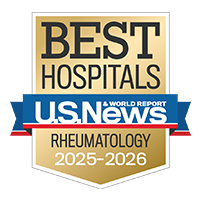Gout

Overview
Gout is one of the most painful forms of arthritis and one of the few in which the cause is known. In many cases, inflammation initially develops in the joints of the big toe, a condition called podagra. It also can affect the instep, ankles, heels, knees, wrists, fingers and elbows.
Although there is no cure for gout, the majority of patients are able to manage their symptoms with medications. The disease typically affects men over the age of 30, post-menopausal women, African Americans, people with kidney disease and those who have had an organ transplant. In addition, some families are genetically predisposed to the condition. Gout is strongly associated with obesity, hypertension, hyperlipidemia and diabetes.
The condition results from deposits of needle-like crystals of uric acid in the connective tissue and joint spaces. Uric acid is a byproduct of the breakdown of waste products in the body. Normally, uric acid is eliminated through the urine. When the body increases its production of uric acid or if the kidneys do not eliminate enough of it from the body, levels build up and cause gout.
Our approach to gout
UCSF provides comprehensive evaluations and advanced care for all forms of arthritis, including gout. Our team includes doctors from several specialties, including rheumatology, orthopedic surgery, dermatology and plastic surgery. We offer specialized imaging studies and immunologic testing, as well as a range of standard and investigational treatments.
Gout is caused by a buildup of uric acid in the body. Most patients are able to ease symptoms and stop a gout attack with either nonsteroidal anti-inflammatory drugs or corticosteroids. Patients who suffer repeated gout attacks or advanced gout may need different medications to normalize their levels of uric acid.
Awards & recognition
-

Among the top hospitals in the nation
-

Best in the West and No. 7 in the nation for rheumatology
Signs & symptoms
The hallmark symptom of gout is a sudden, severe attack of pain, redness, swelling and tenderness in a joint, often the first toe. Inflammation also can occur in the knee, ankle, foot, hand, wrist and elbow. Gout typically occurs quickly in only one joint at a time, but symptoms may occur in two or three joints simultaneously.
Deposits of uric acid, called tophi, can appear as lumps under the skin around the joints and at the rim of the ear. Occasionally, uric acid collects in the kidneys and forms stones.
Diagnosis
Your doctor will begin by recording your complete medical history and asking you to describe your symptoms. Then you will undergo a physical examination during which your doctor will check for physical signs of the condition. The best way to diagnose gout is to remove fluid from an affected joint and examine it under a microscope for uric acid crystals. However, this may not always be necessary.
Treatments
Most people with gout are able to control their symptoms and enjoy active lives with the use of proper medication. Treatment aims to reduce pain, prevent future attacks and avoid the development of tophi and kidney stones.
Drug therapy
Nonsteroidal anti-inflammatory drugs (NSAIDs), or corticosteroids, which are either taken orally or injected into the affected joint, are two of the most common treatments for acute attacks of gout. NSAIDs and corticosteroids reduce the inflammation caused by deposits of uric acid crystals, although they have no effect on the amount of uric acid in the body. Patients often begin to improve within a few hours of treatment, and the attack usually goes away completely within a week or so.
Patients who have multiple gout attacks or who develop tophi or kidney stones are candidates for therapy that aims to normalize uric acid levels in the blood. Such drugs include those that help the kidneys eliminate uric acid, such as probenecid, and drugs that block production of uric acid by the body, such as allopurinol. During the initial phases of such treatment, low dose of the anti-inflammatory drug colchicine might be used to prevent a gout attack.
UCSF Health medical specialists have reviewed this information. It is for educational purposes only and is not intended to replace the advice of your doctor or other health care provider. We encourage you to discuss any questions or concerns you may have with your provider.









